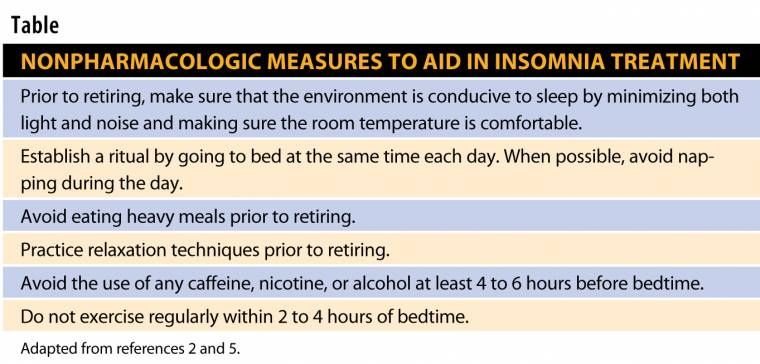Publication
Article
Pharmacy Times
Putting Insomnia to Rest
Author(s):
The cause and frequency of a patient's insomnia help pharmacists determins if OTC treatment is appropriate.
The cause and frequency of a patient's insomnia help pharmacists determine whether OTC treatment is appropriate.
Despite the fact that adequate sleep is vital to one’s overall health and wellbeing, many individuals in the United States do not get enough. According to a 2011 poll conducted by the National Sleep Foundation, an estimated 43% of Americans aged 13 to 64 years admit that they rarely get a good night’s sleep on weeknights, and an estimated 60% report that they experience problems sleeping every night or almost every night.1 Many individuals report that on average they only sleep about 7 hours per night, and an estimated 15% of adults aged 19 to 64 years and 7% of those aged 13 to 18 years report getting less than 6 hours of sleep on weeknights.1
Insomnia is a common complaint— ranking third after headaches and the common cold—that can significantly affect an individual’s quality of life.2 Pharmacists are in a pivotal position to identify the medical conditions or pharmacologic agents that may exacerbate episodes of insomnia and help patients make informed choices regarding management and treatment.2
An estimated 9% of the adult population in the United States has used some type of nonprescription medication to manage their insomnia.2 Statistics from the National Center for Sleep Disorders at the National Institutes of Health indicate that approximately 30% to 40% of adults experience 1 or more of the symptoms associated with insomnia within a given year, and 10% to 15% report episodes of chronic insomnia.3,4
Statistics also show that insomnia is more prevalent among older individuals and women. Many female patients report problems sleeping during menstruation, pregnancy, and menopause.2 As individuals age, the frequency of insomnia increases. 2,3 Patients with medical conditions such as hypertension, arthritis, heartburn, gastroesophageal reflux disease, depression, diabetes, and cardiovascular disease are most likely to report problems sleeping.2
Patients who work night or off-hour shifts and those with sleep apnea may also be at greater risk of developing insomnia.2 Unfortunately, only a small percentage of patients actually report symptoms or discuss their sleep problems with their primary health care provider.2
Results from a study published in the September 1, 2011, issue of Sleep found that insomnia results in 11.3 days per year of lost productivity for the average US worker; the total cost to the health care system is estimated at $63.2 billion per year.5 The effects of insomnia may go unrecognized or may be thought of as unimportant; however, if left untreated, the condition can lead to other health issues.
Findings published in the August 29, 2011, online issue of the journal Hypertension reinforced previous research linking sleep problems with obesity and cardiovascular issues.6 The study found that men with the lowest level of the deeper stages of sleep had as much as an 80% higher risk of developing hypertension when compared with men with the highest level of restorative sleep.6
Causes of Insomnia
Individuals with insomnia may present with complaints of trouble falling asleep, difficulty staying asleep accompanied by episodes of frequent waking, and not feeling completely rested upon waking.1 A number of psychological, physical, and environmental factors may contribute to or exacerbate episodes of insomnia. Examples of common factors include1:
- Episodes of stress, anxiety, or depression
- Alterations in environment, routine,
- Certain medical conditions such as arthritis, congestive heart failure, gastric reflux disease, respiratory disorders, psychiatric disorders, nocturia, and restless leg syndrome
- Use of certain pharmacologic agents such as antidepressants, antihypertensives, and sympathomimetic amines
- Use of caffeine, nicotine, or alcohol
Types of Insomnia
In general, insomnia is classified as primary or secondary. Primary insomnia typically lasts for 1 month or longer, is not the direct result of another sleep disorder, general medical condition, or psychiatric disorder, and is not attributed to the use of any pharmacologic agent.2,5 Secondary insomnia is the most prevalent form of insomnia, accounting for 8 of every 10 cases, and is the result of another identifiable underlying source such as certain medical conditions or pharmacologic agents.7-9 Insomnia can be further categorized, based upon the duration and severity of the episodes, as follows2,7-9:
- Transient (self-limiting and lasting less than 1 week; often caused by temporary stress, anxiety, or schedule changes)
- Acute or short-term (lasting 1 to 3 weeks; often caused by prolonged stress or anxiety caused by the death of a loved one, financial problems, etc)
- Chronic (lasting more than 3 weeks; often the result of medical conditions, mental disorders, or substance abuse)
Managing and Treating Insomnia
Insomnia can negatively impact an individual’s ability to perform daily routine tasks, which in turn can result in irritability, difficulty concentrating, cognitive impairment, extreme fatigue, and anxiety. It is important to evaluate the possible causes, duration, and severity of the symptoms of insomnia before recommending any type of treatment, in order to determine the most appropriate approach. The patient’s medical history, current medication profile, and allergy history should also be taken into consideration.
Nonprescription drugs marketed for insomnia are indicated for the treatment of transient and short-term sleep disorders in individuals who occasionally experience sleep problems.2 Available formulations include single entity antihistamine products containing diphenhydramine or doxylamine, which come in different dosage forms, and antihistamine-analgesic combination products, which are indicated for individuals whose insomnia is the result of uncontrolled pain.
Both diphenhydramine and doxylamine are ethanolamine antihistamines and are thought to affect sleep by blocking histamine-1 and muscarinic receptors.2 The majority of nonprescription sleep aids contain diphenhydramine and should be taken 30 to 60 minutes before bedtime and should be used only as needed. Patients should be advised not to exceed 50 mg and not to take the medication for longer than 14 days unless directed by their physician.2 In addition, a number of complementary and alternative therapies are available, including melatonin products, valerian, and kava.2

Counseling Points
During counseling, pharmacists should encourage patients to discuss their sleep issues with their primary health care provider, especially if the insomnia shows no signs of improvement or worsens. Prior to recommending any nonprescription drugs for insomnia, pharmacists should screen for potential drug interactions or contraindications, and should remind patients that nonprescription sleep aids are indicated for short-term use.2 Pharmacists should refer patients with chronic insomnia for further medical evaluation when warranted.
Individuals who use OTC sleep aids should be advised of the potential adverse effects associated with these products, which include morning grogginess, dry mouth, constipation, and blurred vision.2 Prior to recommending any nonprescription sleep aids, pharmacists should ascertain whether the patient is an appropriate candidate and ensure that he or she understands the proper use of these products. Patients should be advised to adhere to the recommended dosage guidelines and should be cautioned to avoid tasks such as driving or operating machinery until their response to these products is known.2 Patients should also be reminded to avoid the use of alcohol when taking these products.
OTC sleep aids are contraindicated in patients with prostatic hyperplasia, those who have difficulty urinating, and those with glaucoma, emphysema, or chronic bronchitits.2,10 Patients with cardiovascular diseases such as angina may be more susceptible to the anticholinergic adverse effects of these products and therefore should not use them.10 Individuals with insomnia who are 12 years and younger or 65 years and older, are pregnant or breast-feeding, or have preexisting medical conditions should consult their primary health care provider prior to using any of these products.
Patients should be counseled not to take any other sleep aid products or any other products that may contain antihistamines— including topical antihistamine products—while taking OTC sleep aids. In addition, pharmacists can suggest nonpharmacologic measures that may increase the likelihood of a good night’s sleep (Table) and should always refer patients with chronic insomnia to their primary health care provider to discuss the prescription drugs available for the treatment of insomnia. PT
Ms. Terrie is a clinical pharmacy writer based in Haymarket, Virginia.
References
1. Annual Sleep in America Poll exploring connections with communication technology use and sleep. National Sleep Foundation Web site. www.sleepfoundation.org/article/press-release/annual-sleep-america-poll-exploring-connections-communications-technology-use. Accessed September 18, 2011.
2. KirkwoodC, Melton S. Insomnia. In: Berardi R, Newton G, McDermott JH, et al, eds. Handbook of Nonprescription Drugs. 16th ed. Washington, DC: American Pharmacists Association; 2009:869-881.
3. Insomnia facts. National Sleep Foundation Web site. www.sleepfoundation.org/sleep-facts-information/study-hall. Accessed September 16, 2011.
4. One—third of Americans lose sleep over economy. National Sleep Foundation. www.sleepfoundation.org/sites/default/files/2009%20NSF%20POLL%20PRESS%20RELEASE.pdf. Accessed September 15, 2011.
5. High cost of insomnia may be wake up call. Medline Plus Web site. www.nlm.nih.gov/medlineplus/news/fullstory_116033.html. Accessed September 18, 2011.
6. Poor sleep, high blood pressure. Medline Plus Web site. www.nlm.nih.gov/medlineplus/news/fullstory_115892.html. Accessed September 18, 2011.
7. Kelly J.Insomnia lasts for years if left untreated. Medscape Web site. www.medscape.com/viewarticle/589428. Accessed September 17, 2011.
8. Insomnia. Medline Plus Web site. www.nlm.nih.gov/medlineplus/ency/article/000805.htm. Accessed September 17, 2011.
9. Types of insomnia. Shuteye.com Web site. www.shuteye.com/what-is-insomnia/types-of-insomnia.aspx. Accessed September 17, 2011.
10. Diphenhydramine product information. Medscape Web site. www.medscape.com/druginfo/dosage?drugid=93203&drugname=Diphenhydramine Citrate Oral&monotype=default. Accessed September 17, 2011.







